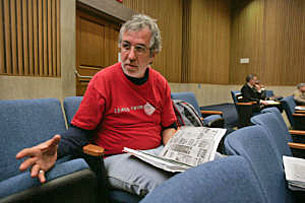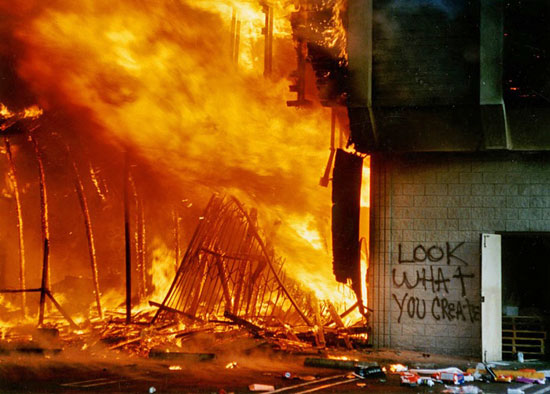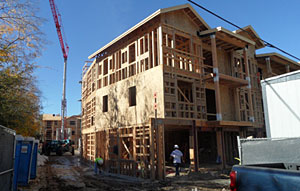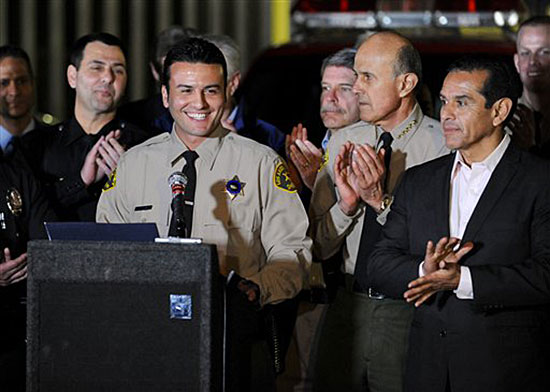Featured
A Memorial Day to remember
May 25, 2012

Another summer is upon us, as marked by our upcoming three-day weekend. No doubt, there’ll be lots of department store sales and plenty of backyard barbecues. But too often lost in the Memorial Day festivities is the holiday’s more somber meaning—a day of remembrance for those who’ve died in the nation’s service.
For so many families among us, the wounds of loss are fresh and deep. During the past decade, more than 6,400 men and women have died in Iraq and Afghanistan. My prayers go out to their heartbroken loved ones. The trauma, of course, does not stop there. At this moment, thousands upon thousands of others are struggling mightily to overcome debilitating trauma to their bodies and minds.
I hope you can find a few minutes to commemorate Memorial Day. To help you, the county’s Department of Military and Veterans Affairs has compiled its annual comprehensive list of events, including many that offer special discounts to members of the military and their families. Maybe one way to recognize those who’ve perished in our recent wars is simply to explore the Washington Post’s excellent Faces of the Fallen. Among my plans for the day, I’ll be at the Canoga Park Memorial Day Parade.
My fondest hope is that those individuals now bravely serving in danger zones across the planet will return to us safely so that next year we can celebrate, rather than mourn, them.
Posted 5/25/12
Searing lessons of the riots
April 26, 2012
It was several hours after the Rodney King verdicts and the city had yet to exhale. Shocked by the police acquittals, I headed to First AME Church with Mayor Tom Bradley and other civic and religious leaders to urge calm. When we stepped inside, the streets were quiet—which is why I was taken aback a short time later by the pictures of fire and violence on a TV reporter’s monitor inside the church.
“Why are you showing the ’65 Watts Riots?” I asked in a challenging tone.
“Councilman,” he said, “that’s a live shot from our helicopter.”
Within moments, I was being accompanied by a church deacon to my city car, parked near the intersection of Adams and Western. “You cannot walk there yourself,” I was told firmly. By then, every window of the vehicle had been smashed out. I was driven home by an aide to Councilman Nate Holden, who represented the area.
Today, 20 years later, images of those cataclysmic days seem as distant as the Watts Riots did to me on that evening at First AME. There’s almost a grainy, historical look to the photos and videos we’ve seen resurrected in recent days, creating a sense that this dark and transformative moment in our history is long behind us.
Yes, many of the conditions that led to the 1992 explosion of lawlessness have been repaired. One of the most significant events in the aftermath of the riots—the Christopher Commission—has led to a Police Department that is now making headlines for its partnership with minority neighborhoods, not for its hostile disrespect towards them. Today, residents in areas once deprived of the most basic commerce have access to supermarkets and businesses, though still not enough.
And imagine, two decades ago, launching a new transit system through some of the most charred stretches of the region, as we’re doing today with the Expo Line.
So when the question is asked—could it happen again?—many of us, thinking with our hearts, want to say no, of course not. But I think that would be naïve and dangerous. Although police brutality may have been the match that lit the fuse, the riots drew fuel from economic conditions that for years bred deep resentment—conditions that persist today.
We have yet to provide credible hope to those on the lower end of the income scale that they can work their way into the middle class. Employment, affordable housing, health insurance, child care, quality education, all these things and more continue to elude families living in communities enveloped by the 1965 and 1992 riots.
Too often, federal, state and local governments responsible for confronting such issues seem more interested in pointing fingers than in finding solutions. At the minimum, we elected officials must talk with the most marginalized among us and hear the challenges in their lives. The lack of such communication was one key reason the Los Angeles power structure was blindsided by the breadth of the unrest. I know this may sound ridiculously basic, but the fact is that it’s harder to ignore a person’s plight once you’ve had a conversation with them.
Today, from my vantage point on the Board of Supervisors, I can confidently state that our local governments have not shrunk from the challenges brought into harrowing relief by the flames of 20 years ago. We’ve funded neo-natal programs and created school-based health centers to make sure people, especially the youngest amongst us, receive the care they need and deserve. We’ve pushed for a “living wage” for workers at the lowest end of the earning scale. We’ve begun to clean the urban environment and create parks in communities that once offered little more than asphalt. And we’ve embarked upon an ambitious rapid transit agenda that will create thousands of jobs and bring rail transportation to neighborhoods that have gone without it for far too long.
All these share this in common: respect for human dignity. So long as we honor that notion and dedicate ourselves to reducing economic disparities, there is hope we can transform the lives of individuals and communities for the better.
Posted 4/27/12
Homeless team gets to work
March 28, 2012

Homeless service provider Step Up on Second built this Santa Monica complex for permanent supportive housing.
The occasion was the inaugural meeting of the Interdepartmental Council on Homelessness, a body created through a Board of Supervisors motion authored by Mark Ridley-Thomas and myself. And make no mistake, despite the bureaucratic-sounding name, the council will make a measurable impact on homelessness because, for the first time, we’re pursuing a clearly defined county strategy: to provide permanent supportive housing with vital services to those most likely to perish on our streets.
In other words, if you want to end homelessness, then you must provide a home.
We know from our own experience that this “housing first” approach works. Back in 2007, in that same Hall of Administration conference room, we launched a pilot program called Project 50, championed by my office to house and provide supportive services to Skid Row’s 50 most chronically homeless people. Unlike earlier, narrower efforts, this one required coordination among multiple county agencies with varying responsibilities for this extraordinarily difficult population.
The goal was not only to save lives, but to save money, too, by reducing the high public cost of emergency room care and incarceration historically associated with chronically homeless individuals.
Since the successful launch of Project 50, the concept has been replicated throughout my 3rd District—in Santa Monica, Venice, Hollywood and the San Fernando Valley. The United Way has adopted the approach for its ambitious “Home for Good” campaign, as has the Department of Veterans Affairs with its own Project 60 in collaboration with my office. In all, more than 500 people have been placed in permanent supportive housing since the initiation of Project 50.
Now, with the establishment of the interdepartmental council, Los Angeles County is finally aligning its will and existing resources behind the housing-first model, offering real hope to the most vulnerable among the 51,000 souls in our county without homes. Around the table on Wednesday were top officials from such crucial departments in the fight against homelessness as mental health, children and family services, probation, health services, public health, social services, community development, the superior court and sheriff’s department.
To be sure, we face a huge challenge here, in the nation’s epicenter of homelessness. And our vast county bureaucracy is not naturally inclined toward this kind of multi-agency plan of attack, one that eliminates barriers and accelerates the time between an idea and its implementation.
Still, as the council’s first chairman, I’m convinced that in the months and years ahead we can house not just hundreds, but thousands of people who, like any other resident of our county, deserve more than another well-intentioned plan that ends up on a shelf gathering dust.
Posted 3/28/11
Tough times, good partners
March 20, 2012
For the past several years, all of our county labor unions have gone without a pay raise. In the case of our sheriff’s deputies, firefighters, lifeguards, probation officers and public defender investigators, it’s been three straight years.
Now they’re about to make it four in a row.
With the Board of Supervisors’ approval this week of another one-year contract extension with our public safety labor partners, I thought it was time to pause for a moment and say thank you. Our employees’ willingness to step up to the plate in these difficult times is one of the reasons our county finds itself in much better shape, relatively speaking, than most other municipalities throughout California, as well as the state itself.
Our unique and healthy partnership with labor, together with the long-running fiscal discipline shown by the Board of Supervisors, is paying dividends as we continue to weather a difficult economic environment.
I’m not saying that it’s been easy, or painless. But we have gotten through the financial crisis to date without having to lay off or furlough a single employee. This is particularly important in these tough times, when demand for the county’s safety net services soars.
Thanks go as well to my board colleagues and to our Chief Executive Office. Together with our labor partners, I believe we’ve created an atmosphere of mutual trust—one in which relatively modest sacrifices today help avert far more painful consequences tomorrow.
I’ve written in this space before about how we’ve gotten to this point—how our current policies of prudence and restraint grew out of the lessons learned during a financial rough spell back in the mid-1990s when the county was spending beyond its means to the tune of $1 billion a year. That wake-up call, shortly after I joined the Board of Supervisors, is an alarm that none of us wants to hear ever again.
So now, as we see other local and state governments in tumult around us—and as we continue to grapple with hard choices in our own budget—we can take satisfaction in what we’ve been able to accomplish together.
All of our employees are still working. They’re still putting food on their families’ tables. And they’re still serving the people of Los Angeles County. And in this economic environment, that’s a remarkable thing.
Posted 3/20/12
Thoughts on a rock star
February 29, 2012
During the next week, you’ll surely see lots of pictures of a huge red contraption hauling a shrink-wrapped boulder along the streets of four counties, inching its way at night toward the Los Angeles County Museum of Art.
And I suspect some of you will be asking yourselves (and others), why all the fuss over a 340-ton chunk of granite from some Riverside quarry? This, you call art?
My answer to that, in a word, is yes. That said, I do understand some of the skepticism, which is why I thought I’d share with you what I find so inspiring—so artistic—about this monumental, privately-funded project.
The boulder is just one facet of a work called “Levitated Mass,” conceived by Michael Heizer, the reclusive Nevada artist who has dedicated himself for decades to massive undertakings using the offerings of the earth as his primary media. At LACMA, The Rock, as it has come to be called, will be positioned over a concrete trench that allows visitors to walk underneath, creating a sense that the boulder is levitating.
“Levitated Mass” and Heizer’s other big, outdoor projects are reminders to me of how small, physically, we are in the scheme of things. They almost demand humility and introspection. Indeed, the whole oversized effort—the transport, the engineering required to install the rock at LACMA, all of it—is part of the art to me.
Some people, of course, will always view Heizer’s LACMA work as simply a big rock. But to others, including me, it will represent something far more emotional and soulful. And that’s as it should be given the subjective nature of art—or, in this case, the art of nature.
The other night, in the chill air of Riverside County shortly before The Rock finally hit the road, I was struck by how the ambition of one man’s vision could not be realized without the specialized collaboration of so many others—the quarry workers, the hard-hatted crew responsible for moving the rock, the beaming museum executives who pulled together the funding. Then there were the scores of spectators who knew they were witnessing something special, something transcendent.
“This is a once in a lifetime experience, to see something like this,” said one. “This has been here for like 20,000 years, and now it’s art.”
My thoughts exactly.
(Click here for a map of where you can see The Rock as it makes its journey to LACMA.)
Posted 3/1/12
It starts at the top
February 23, 2012
Philip Browning is one of the smartest and most able public administrators on the local government scene anywhere in America.
We just named him to a job that will require every one of his talents—and then some.
As the new director of the county’s Department of Children and Family Services, Browning is leading the charge to reform a department in need of strong management after years of fear, indecision and secrecy that often kept policy-makers and the public needlessly in the dark. Too many vulnerable children ended up suffering and, in some tragic cases, dying when they should have been protected.
Now, Browning is hitting the re-set button at DCFS. It is a gargantuan task—so much so that I told him, not entirely in jest, that I was listening closely during his swearing-in ceremony last week to make sure I heard him say under oath that he was taking the job “freely and without mental reservation.”
Yet despite all the many challenges ahead, I feel hopeful about the future.
That’s because Browning is a real leader—someone who can move his staff forward through inspiration, not fear, and who gets results through competence and accountability.
He is able to articulate a clear vision for where the department needs to go. He gives everyone around him an opportunity to be heard.
And he’s a proven turnaround artist. His first assignment when he arrived in Los Angeles County in 2001 was to overhaul the county’s child support operation—which was so fraught with troubles that it was a rare day that my office, and every other supervisor’s, didn’t receive multiple complaint calls about it. Once Browning was through, the complaints had dwindled to near zero—and recoveries from deadbeat parents had skyrocketed by 36%. From there, he moved on to head the county’s Department of Public Social Services, which under his leadership was able to reduce the food stamp error rate and save the county sizeable penalties as a result.
Never have Browning’s skills been more desperately needed than at DCFS. His mandate is to completely transform the culture of a department where accountability and common sense have been in short supply, and where fear of making a wrong decision has frequently led to the worst move of all: doing nothing.
That’s not Browning’s style. Yes, he has genteel manners and a gentle Alabama accent, but this is one canny and decisive manager.
He hit the ground running when the Board of Supervisors asked him to take over the department as interim director last August. When he saw a spike in the placement of children in group homes—widely viewed as a less-than-desirable situation, especially for young kids—he stepped in with a new set of policies to discourage the practice. Now, 8-year-olds and younger children may not be placed in group homes without his personal approval or that of his chief deputy.
He believes in, and lives by, statistics. Metrics from each regional office are now beamed up on big screens for all to see—and act on—at monthly management meetings. Bulletin boards have been installed in all the regional offices, too, with the same statistics openly on display. In some ways, it reminds me of former Police Chief Bill Bratton’s statistics-driven approach to successful law enforcement.
But Browning is not just a numbers guy. He’s also a personable, hands-on leader. Staffers say they are encouraged and energized to have a top boss who communicates often and well, sets clear but ambitious goals and is a visible presence around the department. “We have much to do, but with you we can go all the way,” one manager told him the day he was appointed.
This isn’t a job that Browning sought. I’ll admit that I and others of my board colleagues had to work hard to persuade him to make the jump from interim to permanent director. But we appealed to his better angels and convinced him of how much the county, and its children, need him in this position.
It is a life-and-death challenge. These kids are the most vulnerable human beings in our society. Many have been literally bounced around—physically abused and shuffled from placement to placement. They deserve better.
In fact, they deserve the best. And we’re very fortunate that the best is now leading—with inspiration—from the top at DCFS.
Posted 2/23/12
A public comment of my own
January 24, 2012

Gadfly Arnold Sachs says he likes to "annoy the board" by speaking on every agenda item. Photo/Daily News
For the past several weeks, a lot has been said and written about my proposal to modify the amount of time each member of the public is allotted for comment during our weekly Board of Supervisors meetings.
Unfortunately, much of that discussion has lacked balance, context and, at times, accuracy, thus serving mostly to misinform people about what I’d hoped to achieve upon becoming the board’s chairman in December. As a result, the prevailing narrative has become this: we on the Board of Supervisors believe that when it comes to our meetings, the public should be neither seen nor heard.
The most recent example of this was a lengthy story in Saturday’s Los Angeles Times. Appearing on the front page, it flatly and wrongly asserted that I think “members of the public talk too much” and mischaracterized fundamental elements of the proposal. Inexplicably, I was never asked for my comment, even though the piece was aimed squarely at me. Had I been asked to do so, readers would have come away with a fuller understanding of the issue.
The truth is I wish we had more public engagement. Our huge hearing room is often empty, despite the breadth and enormity of matters the board confronts every week. In this regard, we are not alone. Visit City Hall and you’ll find much the same. Recent coverage would have you believe that we want to yank the microphone on a public that’s clamoring to be heard. This is not the case.
Most weeks, the same tiny cadre of individuals speak on a multitude of agenda items—sometimes dozens of them in a single meeting. Under the current practice, they’re allowed to talk for two minutes on each item and then can speak for an additional three minutes at the end of the meeting on non-agenda matters. One of these so-called gadflies admitted to a Daily News reporter recently that he had signed up to talk on every agenda item simply to “annoy the board.”
Of course, this is his right—as it is the right of another of our regular speakers to participate in this weekly spectacle by repeatedly delivering the same racially-tinged diatribe against undocumented immigrants and reciting the names and addresses of those she alleges, without evidence, of being “gangbangers.”
But under California’s Ralph M. Brown Act, it’s also the right of government bodies to impose reasonable limits on public comment as a way to ensure a healthy balance among all stakeholders in the meeting process. All our local legislative bodies have rules to this effect, including the Los Angeles City Council. In this spirit, and at the suggestion of our County Counsel, I proposed that our rules be modified to give speakers a three-minute block to discuss their agenda items—rather than two minutes for each one—and two minutes at the end of the meeting for general comment.
While this might be a tight squeeze for the small number of gadflies bent on testifying about virtually every matter before us each week, we considered it a fair policy for the vast majority of people who, in good faith, take time out of their days to travel downtown and speak on the one or two issues that directly affect their lives.
Now, we’ve put the proposed changes on hold so that our county attorneys have time to correct misperceptions and explain the board’s motivation to concerned stakeholders as we move forward.
For those of you who’ve followed my time in public life, you know that I’ve been a consistently strong advocate of government transparency—a record that includes, among other things, my successful push to make board meetings available to a wider audience by having them webcast, televised and posted online with transcripts. As some of you may also remember, I authored Los Angeles’ first freedom of information act while serving on the City Council.
So I encourage you to join me at a Tuesday Board of Supervisors meeting and see for yourself what all the controversy is about. You be the judge. Take it from me, you can’t trust everything you read.
Posted 1/24/12
Affordable housing still matters
January 18, 2012
Redevelopment agencies may have begun with noble ideals. But all too often in recent years they have devolved into slush funds for insiders—not to mention a bureaucratic means of denying our schools, social service agencies and fire departments the resources they needed to make California a better place to live and work. Auditors throughout the state are now starting to open the books of these agencies. And I believe the public will be shocked by what they find—including huge sums wasted on frivolous projects or left to idle in agencies’ coffers while vital community needs were ignored.
So I applaud the California Supreme Court’s recent decision to uphold state legislation that puts redevelopment agencies out of business starting February 1.
But that doesn’t mean we can afford to ignore the funding stream that some of these redevelopment agencies—notwithstanding their glaring flaws—provided for desperately-needed low- and moderate-income housing, along with some other legitimate local development purposes.
So this week, we took the first steps toward making sure our current affordable housing programs transition smoothly to new management as our redevelopment agency dissolves, and receive the strong and appropriate levels of oversight mandated by the new state law. (Here is the motion I co-sponsored with Supervisor Mark Ridley-Thomas.) We also directed county staff to begin working on a new framework for how we will fund and manage affordable housing programs going forward. (My motion is here.)
There’s not a moment to waste.
At a time when federal housing resources are being slashed by nearly 50% each year, Los Angeles County must take the lead in quickly identifying ways to continue providing the means to build affordable housing for the most vulnerable among us.
Over the past few years, the need for such housing has skyrocketed as the resources have shrunk exponentially. A recent survey found there were nearly 200,000 people on the waiting list for Section 8 housing in Los Angeles County—and that the waiting period is now 10 years. It’s even worse in some cities within the county, including one, in our own 3rd District, where the wait is an astronomical 399 years.
As Los Angeles County and other jurisdictions up and down the state adjust to the complexities of life after redevelopment agencies, we must not lose sight of all the human need behind those terrible statistics.
And we can’t let California’s decision to dismantle these agencies deter us from our responsibility to help people get access to housing they can afford.
Posted 1/18/12
Flames can’t match burning spirit
January 3, 2012
Every now and then, a crime spree spreads through our communities that it is particularly hard to fathom, so senseless and random that it catches us off guard, even in a region that, sadly, is no stranger to crime.
During four days over the New Year’s holiday, we were caught in one of those moments as the Westside, West Hollywood and the San Fernando Valley were unnerved by an arsonist whose motives are still to be discerned. Dozens of residential buildings and many more dozens of cars were torched. Our communities were terrorized as the arsonist lit one fire after another under the cover of darkness.
I live in one of those communities. One fire occurred less than four blocks from my home. The steady drone of sirens in my neighborhood and beyond was evidence of the mayhem’s sweep.
Throughout the night, families took turns keeping watch. Others took to Twitter with updates. Some fought fires with garden hoses. As we so often do in times of trouble, neighbors took care of neighbors and strangers joined forces.
As we’ve come to expect, our public safety organizations once again rose to the occasion. In what felt like an eternity but was just four days, a suspect was apprehended, arrested and criminally charged—a testament to the collective work of agencies operating in “unified command.” The LAPD, the L.A. County Sheriff, the city and county Fire Departments and the federal Alcohol, Tobacco, Firearms and Explosives unit checked their agency seals at the door and worked as one team.
Although several millions of dollars in property damage occurred, no one was killed or injured. Since the suspect’s arrest, the fires have stopped. And for that, we owe an especially big thanks to a grateful immigrant named Shervin Lalezary.
A reserve deputy for the Sheriff’s Department, Lalezary was on just his fourth shift as a $1-per-year volunteer. He was patrolling Sunset Boulevard in West Hollywood when he spotted and pulled over a minivan that reportedly was being driven by the alleged arsonist, who’d soon be taken into custody.
Lalezary came here from Iran as a child after the Ayatullah Khomeini revolution in 1979. He studied hard, went to law school and is now a successful real estate attorney practicing in Los Angeles. But personal success was not enough for him. Lalezary says he was determined to give back to the community that welcomed him as an immigrant. Through the sheriff’s reserve program, Lalezary found his way to contribute. Today, we’re all beneficiaries of his courage and commitment.
Los Angeles has a lot for which to be thankful as we begin the new year. So let me wish you a happy, healthy and peaceful one, indeed.
Posted 1/3/12















 Check for the latest closure information
Check for the latest closure information








